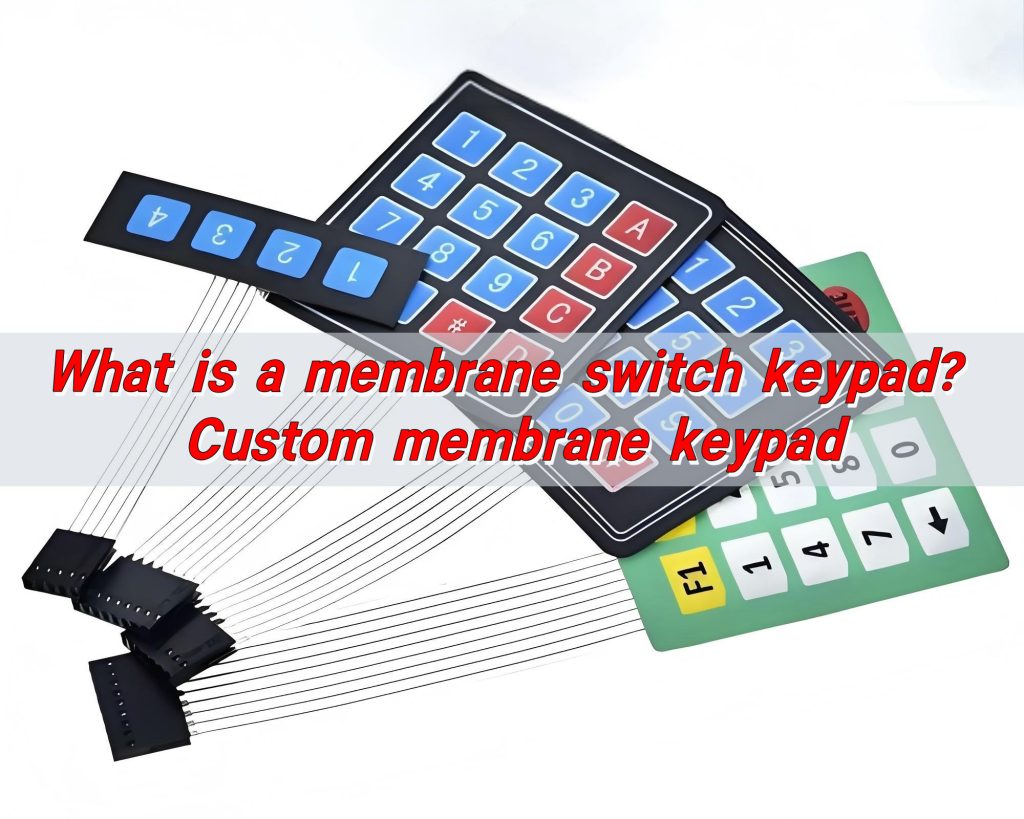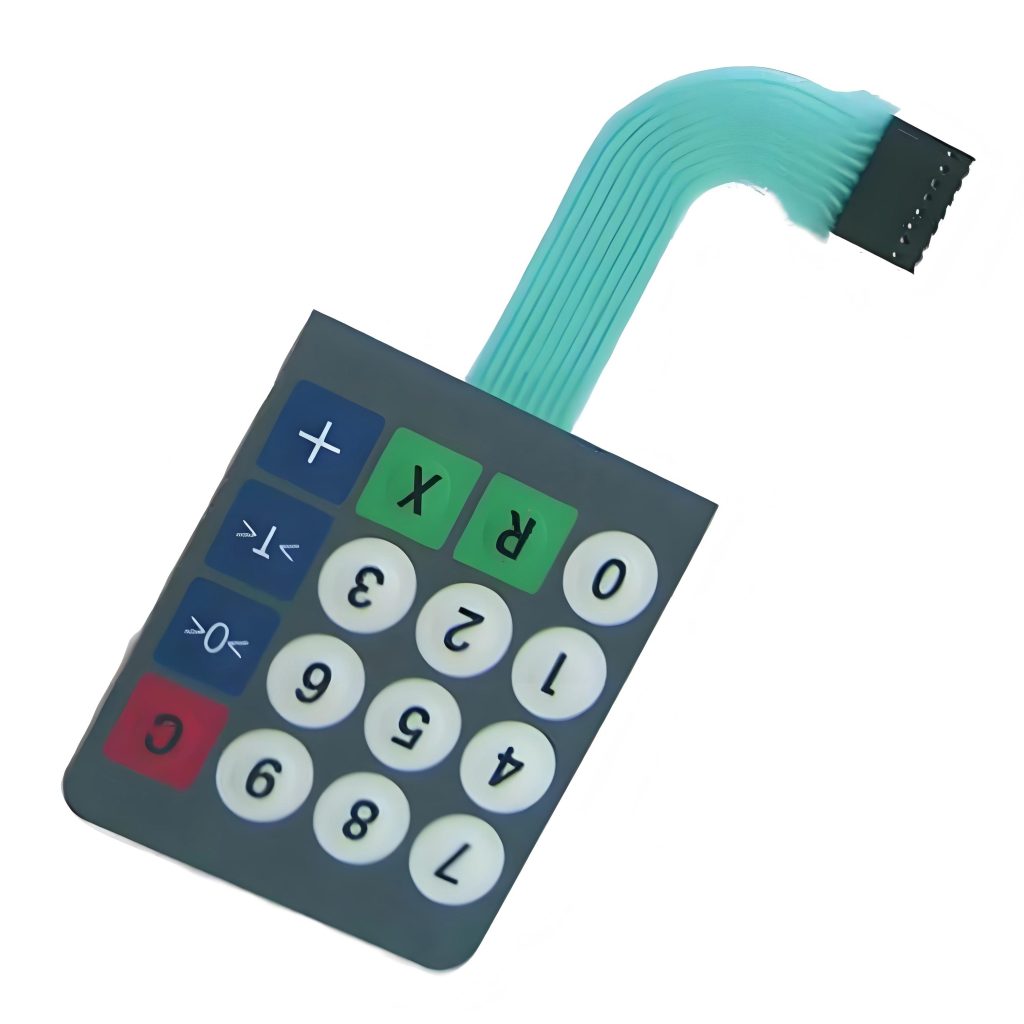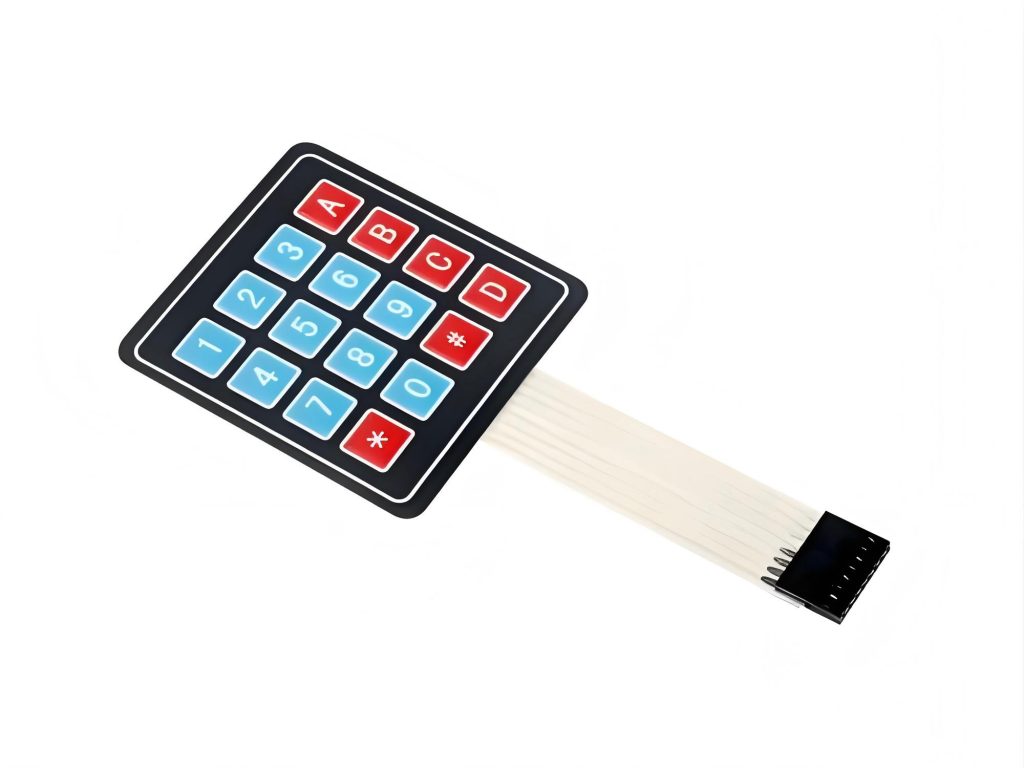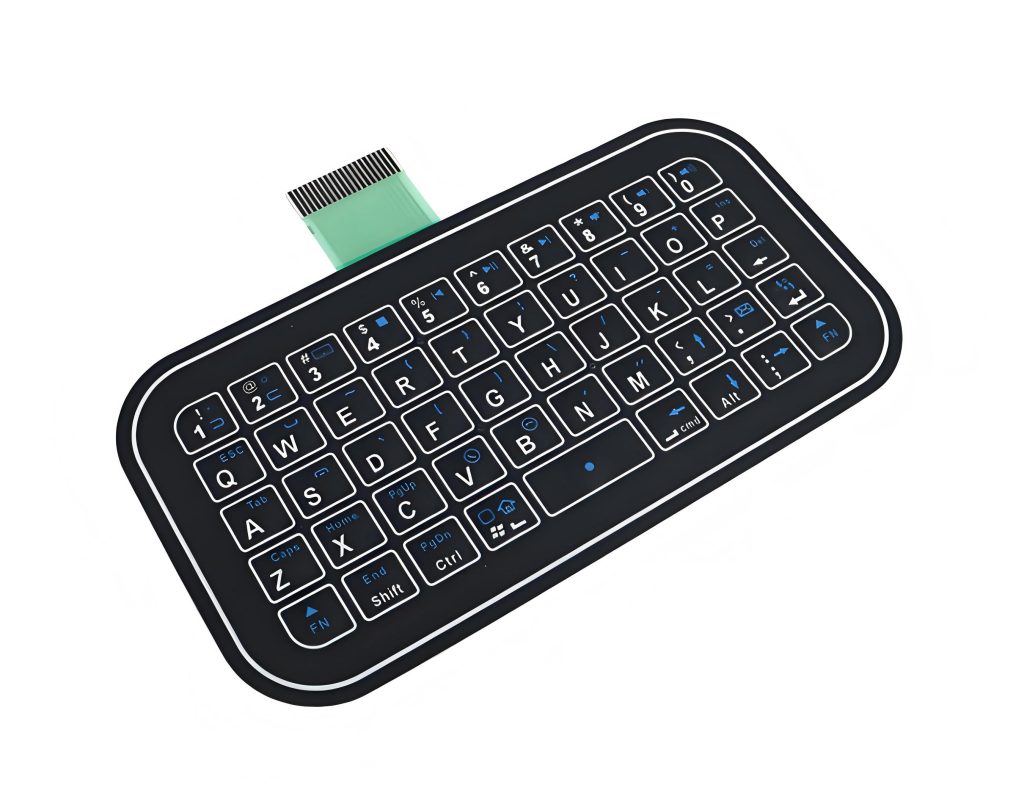
What is a membrane switch keypad? Custom membrane keypad
What is a membrane switch keypad? Custom membrane keypad
What is a membrane keypad?
Mmembrane switch keypad is a layered, low-profile control surface that combines durability with elegant design. Each layer plays a vital role.
The top graphic layer shows symbols and protects inner circuits. Beneath it, an adhesive spacer separates the top sheet from the circuit layer. The bottom layer contains printed conductive traces. When a user presses a button, the upper sheet flexes until it touches the lower conductive layer. That simple motion closes the circuit and sends a signal to the connected device.

This construction delivers several advantages. The surface is completely sealed, so it resists moisture, dust, and oils. The slim form factor fits products with tight space requirements. Custom embossing highlights critical keys and improves grip.
Because of this versatility, membrane keypads appear in medical equipment, industrial control panels, consumer electronics, and automotive systems. They perform well in harsh environments while maintaining a clean, modern look.
Material choice affects both feel and longevity. Polyester overlays withstand more actuations than polycarbonate. Adhesives must endure heat, humidity, and cleaning chemicals.
What are membrane switches on a keyboard?
When someone presses a key, the top film bends until it meets the lower conductive layer. That momentary contact completes the circuit and triggers a command. Release the pressure, and the circuit opens again.
This sealed design keeps out dirt, liquid, and airborne particles. In factories, hospitals, and kitchens, that protection is critical. Equipment stays reliable, even when exposed to cleaning solutions or heavy daily use.
Another advantage is the smooth surface. Without gaps between keys, cleaning takes seconds.
Yu An Electronics can add tactile feedback through metal domes or embossed buttons. These options allow users to clearly feel the click or bump of the key, letting them know that the key has been activated.
Which custom membrane switch fits your project?
Choosing the best custom membrane switch starts with a clear list of requirements. Consider the environment, expected lifespan, and user expectations.
- Environment. Devices exposed to moisture, dust, or chemicals need extra protection. Select overlay materials that resist abrasion and harsh cleaners. Seal the edges with high-grade adhesives to block water or debris.
- Usage frequency. A keypad pressed thousands of times a day requires tough materials. Polyester overlays last millions of actuations. For lighter use, polycarbonate may be sufficient and more economical.
- Circuit design. Decide between silver flex and copper flex circuits. Silver flex supports complex patterns at lower cost. Copper flex handles higher current and offers excellent durability.
- Lighting. Consider LED or fiber-optic backlighting if users need to see controls in low light. Different colors can highlight critical functions.
- Tactile feedback. Metal domes, pillow embossing, or formed keys create a satisfying snap. Choose dome force based on how the product will be used.
- Graphics and branding. Custom printing allows vivid logos, clear icons, and unique color schemes. UV-cured inks resist fading under sunlight or strong indoor lighting.

Partner with Yu An Electronics, an experienced membrane switch manufacturer. Our engineers can recommend the right material, adhesive, and circuit combination. Early collaboration can save time and avoid costly redesigns.
What boosts tactile feel in membrane switches?
Tactile feel is the immediate sensation users experience when they press a key. A strong, precise feel reassures them that a command has been accepted.
- Metal domes. Placing stainless steel domes under the graphic layer adds a sharp snap when pressed. Different shapes—round, four-leg, or triangle—alter the feedback. The size and thickness of the dome also change the required actuation force.
- Embossing. Raised or pillow embossing forms a slight bump on each key. This guides the user’s finger to the correct location and adds a gentle tactile cue.
- Overlay materials. Polyester offers consistent flexibility and springback, enhancing the tactile experience. Polycarbonate feels softer but may wear sooner.
Actuation force selection. Choosing the right force is critical. A handheld medical device might need a light touch to reduce user fatigue. An industrial control panel may require a firmer press to avoid accidental activation.
How to clean a membrane switch panel?
Cleaning a membrane switch panel is simple and fast, yet it protects both appearance and function. Always power down the device before cleaning.
Use a soft lint-free cloth dampened with mild soap and water. Wipe gently across the surface to remove dust and oils. Avoid abrasive pads or harsh chemicals that could scratch or weaken the overlay.
For stubborn spots, a diluted isopropyl alcohol solution works well. Apply it to the cloth, never directly to the panel.
Routine cleaning extends the life of the graphics and maintains responsiveness. Because the surface is sealed, you don’t need to worry about liquid entering the circuitry. This ease of care is one reason membrane keypads remain popular in medical and food-service settings.
How long can a membrane keypad last?
A quality membrane keypad is designed for a long service life. Many exceed five million actuations per button.
Durability depends on several factors. Polyester overlays withstand repeated bending better than polycarbonate. Silver ink circuits provide excellent conductivity and resilience. Sealed edges protect against moisture and chemical intrusion.
Operating conditions also matter. Exposure to extreme heat, UV light, or harsh cleaning agents can shorten life. Proper installation and regular cleaning help maintain peak performance.

When you work with Yu An Electronics, a reputable membrane switch manufacturer, you get documented test data. We can demonstrate life expectancy, environmental resistance, and electrical reliability.
Where is a membrane switch panel used?
Membrane switch panels serve in an impressive range of industries. Their combination of slim design, sealed surface, and customizable appearance makes them a favorite in many applications.
- Medical equipment. Hospitals and clinics choose membrane keypads for patient monitors, diagnostic machines, and infusion pumps.
- Industrial control. Factories and labs use them for machinery interfaces and testing equipment.
- Consumer electronics. Home appliances, remote controls, and fitness equipment feature them for their sleek appearance and long life.
- Automotive and marine. Dashboards, control panels, and navigation systems rely on membrane switches for water resistance and vibration stability.
- Telecommunications. Network devices and handheld radios benefit from compact, lightweight keypads that maintain performance over years of use.
How do membrane keypads cut production cost?
Flexible printed circuits are less expensive to produce than complex mechanical switch assemblies. Assembly is efficient. Layers are bonded using pressure-sensitive adhesives, speeding up production lines. Automated printing of conductive traces further lowers labor expenses.
Long service life also saves money. Because these keypads resist dust, moisture, and cleaning chemicals, maintenance needs are minimal. Fewer replacements mean reduced downtime and lower warranty claims.
Shipping and storage are simpler too. Their light weight and compact form reduce freight costs and warehouse space. For large production runs, these savings become significant.

Partner with experienced membrane switch manufacturer Yu An Electronics to ensure cost-effectiveness without sacrificing reliability. We can recommend materials and designs that maintain high performance while controlling costs.
Conclusion:
Membrane switch keypad combines elegant design, reliable function, and long-term value. Its layered construction protects circuits from dust, moisture, and chemicals while offering endless customization options.
Whether used in hospitals, factories, consumer electronics, or vehicles, a custom membrane keypad provides millions of dependable actuations. For expert guidance or a detailed quote, contact sales@best-membraneswitch.com

Top Membrane Switches for Home Electronics Projects in 2025
You can elevate your home electronic membrane switch project in 2025 with standout models such as the 4×4 Matrix 12 Keys Keypad from SOUSHINE, the rgb-enabled strip switches from Molex, and custom graphic switches by Panasonic. These switches offer slim profiles and reliable performance, making them easy to integrate into your DIY setup. You gain ...

Top tips for fixing PS4 controller conductive film keypads
Are you frustrated because your PS4 controller buttons have stopped working? You are not alone. Many gamers experience issues with the conductive film keypad for ps4. Button failures often happen because of dirt, debris, or rough handling. Take a look at the most common causes: Cause Description Dirt and debris Accumulation in button crevices can ...

Top Membrane Switch Companies Leading the Industry in 2025
You see a dynamic market shaping the future of membrane switch technology. Leading companies like Molex, SOUSHINE, YU AN Electronics, TE Connectivity, Honeywell, Omron, Mitsubishi Electric, Panasonic, Industrial Print Technologies, SCHURTER, XYMOX, Douglas Corp, Dyna-Graphics, ELO Touchscreens, UTC, LUNFENG Technology, and Fujikura drive growth with innovation and global reach. Choosing the right membrane switch company ...
Contact us online